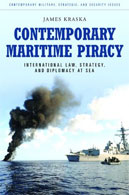Contemporary Maritime Piracy: International Law, Strategy
and Diplomacy at Sea

Author: James Kraska
Santa Barbara, CA: Praeger, 2011. 253p.
Reviewer: Sam Bieler | March 2012
Scholars of maritime security will find James Kraska’s Contemporary Maritime Piracy: International Law, Strategy and Diplomacy at Sea, a versatile reference. Providing wide-ranging, detailed overviews of the historical, legal and policy issues of international piracy, Kraska gives meaningful policy suggestions on dealing with piracy, reinforcing his positions with carefully selected primary source materials that further enhance the book’s usefulness as a reference. Readers interested in a greater understanding of the legal and operational issues in maritime piracy will find Contemporary Maritime Piracy highly informative.
A particular strength of Contemporary Maritime Piracy is its broad yet comprehensive focus. Rather than deal exclusively with one facet of piracy response, Kraska provides an in-depth overview of the historical, military, diplomatic, and legal issues surrounding piracy today, as well as the historical and current status of international piracy. Additionally, the book is not limited to one actor, instead detailing the responses of multiple countries, international regulatory bodies as well as private actors to the problem of piracy. Nor does Kraska restrict his review to a single location. The book covers the well-known piracy issues of Somalia and the Straits of Hormuz, but also discusses piracy problems in the often neglected theater of Southeast Asia. The scope of the book is further increased by the spectacular selection of primary source documents: many of the policy and treaty documents referenced in the book are included in part or in whole as appendices, making this an excellent compact desk reference.
Specific policy suggestions further enhance the value of this work. Each section on contemporary issues includes a series of recommendations that reflect creativity and insight. Kraska’s link between the successful a anti-piracy treaty passed by Asian nations and solutions for the Horn of Africa region is a perfect example of how Kraska blends scholarship and policy. Beginning with an explication of the conditions in Asia that led to the passage of the treaty, Kraska describes the successes from ReCAAP and offers guidance on how these insights might be applied to the Horn of Africa — demonstrating a global insight useful to both researchers and policy makers.
If the book has a shortcoming it is that it reads less as a book and more as a series of separate, albeit strong essays. The lack of a conclusion is a perfect example. Instead of bringing together the different threads discussed into a unified statement or drawing larger conclusions from the carefully researched material, the book comes to an abrupt end following the last chapter on international criminal prosecution. This unconventional style of ending leaves a reader somewhat perplexed as to where to turn next or whether there are larger implications to the carefully considered conclusions with which the author ends each individual chapter. Less critically, regular use of a large number of acronyms also makes the book somewhat intimidating for the casual reader. These are, however, minor points when the overall comprehensiveness of the book is considered. For any diligent researcher, Contemporary Maritime Piracy will be a valuable asset.
Sam Bieler is a graduate student at the University of Pennsylvania.


